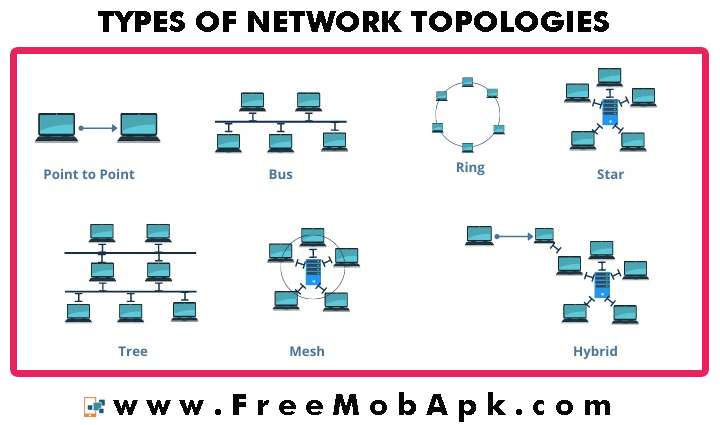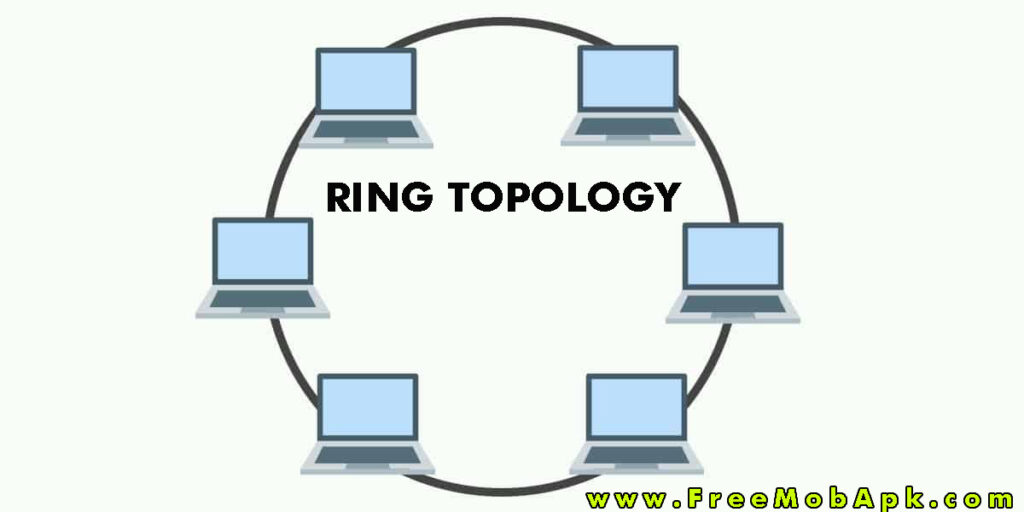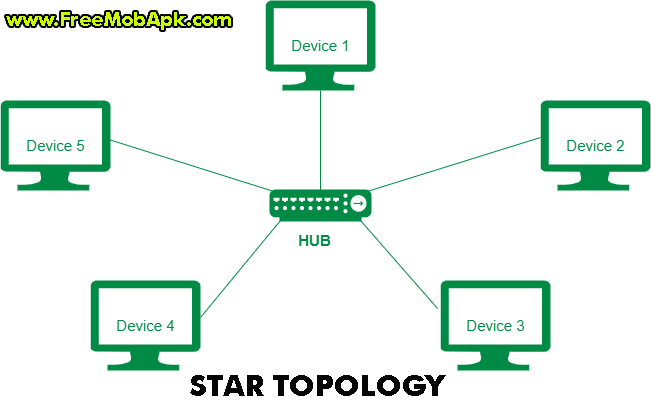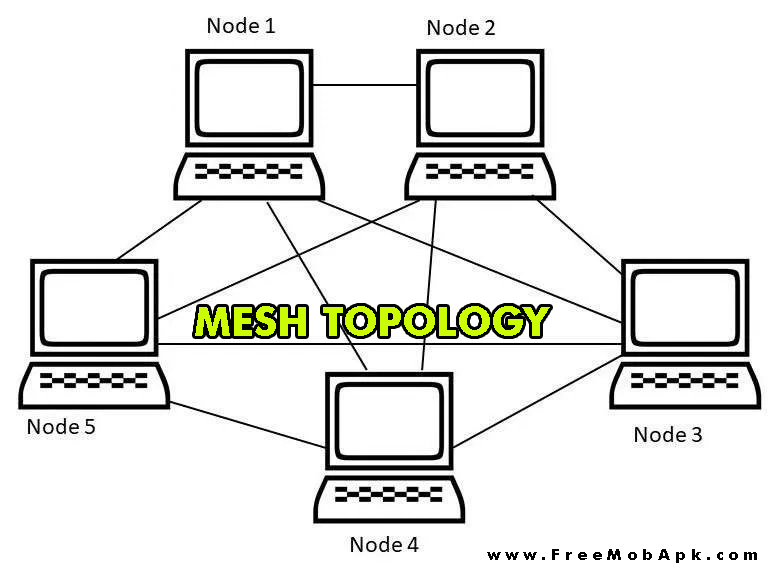A network topology is a model of interconnected network elements. A network topology is a physical, mapping hardware configuration, or logical, construct that maps the path that data must follow to travel across a network.
Several topologies have been defined but not strictly defined. That is, they can all be combined. However, since each topology has a different standard and can use different hardware methods, it is not interchangeable.
What is a Network Topology?
A network topology describes how network links and nodes are laid out with each other. Topologies are divided into physical network topology, which is how physical signals are transmitted, and logical network topology, which determines which data travels through the networks between devices, regardless of the physical connections of the devices. Examples of logical network topologies include Ethernet twisted pairs, classified as logical bus topologies, and token rings, classified as logical ring topologies.
Examples of physical network topologies include star, mesh, tree, point-to-point, ring, hybrid, and bus topologies, each with a different node and link configuration. An appropriate network topology depends on each organization’s size, scope, goals, and budget. Network topology diagrams represent communication devices as nodes, and the connections between devices are modeled as links between the nodes.
Value of Network Topology
Network design directly affects network performance. Choosing the right topology can improve data efficiency, optimize resource allocation, and lower operating costs.
Software-generated network topology diagrams are useful for diagnosing connectivity issues, investigating network outages, and troubleshooting common problems. One of the main uses of network topology is to define the configuration of various telecommunications networks, including computer networks, command and control radio networks, and industrial field buses.
How Should Network Topology is Used?
One of the main uses of network topology is to identify and define the configuration of various communication networks, such as computers and radios. In other words, network topology helps users understand two things:
• Various network elements and where they are connected
• How the network elements interact with each other and what they can expect from their work. Topology is important for business as it allows for a smoother communication system and can constitute a noticeable economic save.
Topology helps to create a better network connection. More and more businesses rely on technology and are increasingly connected. How and where the topology is used: it gives the user a better plan to understand all network parts.
Types of Network Topology

There are two types of network topologies in computer networks:
1) Physical Topology
2) Logical Topology
Physics Topology:
This type of network is the actual arrangement of cables for computers and other network devices.
Logical Topology:
Logical topologies provide information about the layout of the physical design.
The types of physical topology are:
- Point-to-Point Topology
- Bus Topology
- Ring Topology
- Star Topology
- Tree Topology
- Mesh Topology
- Hybrid Topology
Let’s talk about each topology in detail.
Point-to-Point (P2P)
A peer-to-peer network consists of two hosts, such as computers, switches, or routers, and servers connected back to back using a single cable. Usually, the receiver from one host connects to the sender from another host and vice versa.

If hosts are logically connected point-to-point, they can have multiple intermediary devices. However, the end hosts are unaware of the underlying network and see each other as directly connected.
Bus Topology
All devices share a single communication line or cable in a bus topology. Bus topology can be a problem when multiple hosts send data simultaneously. Therefore, the bus topology uses CSMA/CD technology or identifies the host as the bus master to solve the problem. This is one of the simplest forms of networking, where the failure of one device does not affect the other. However, failure of the shared communication line can cause all other devices to stop working.

A line terminator is present at the shared channel’s two ends. Data is sent in one direction, and the terminator removes the data from the path when it reaches the endpoint.
Ring Topology
Each host is connected to two other machines in a ring topology, forming a circular network structure. When a host tries to communicate with or send a message to another host, the data passes through all the intermediate hosts. Administrators may only need one cable to add another host to an existing structure.

Failure of one host can cause the whole ring to fail. Therefore, every joint in the ring is a point of failure. There is a way to use a second reservation.
Star Topology
In a star topology, all hosts are connected through a point-to-point connection to a central device called a hub. That is, a point-to-point connection exists between the host and the hub. A hub device can be one of the following:
1: Devices, such as repeater or hub
2: Devices such as switches and bridges
3: Devices such as routers and gateways

One single point of failure is the hub. If the hub fails, the connection from all hosts to all other hosts fails. All communication between hosts takes place through only the hub. Connecting to a secondary host in a star topology is cheap; he only needs one cable and is easy to set up.
Tree Topology
Also known as Hierarchical Topology, this is the most common network topology used today. This topology mimics the shape of an extended star topology and includes the properties of bus topology.
This topology divides the network into multiple levels /layers of the network. Mainly in LAN networks, he divided it into three network types. The bottom layer is the access layer that connects to the computer. The middle layer is called the distribution layer and acts as a medium between the layers above and below. The top layer, called the core layer, is the midpoint of the network, the root of the tree, from which all nodes branch.

There is a point-to-point connection between each neighboring host. Same to the bus topology, a routing failure affects the entire network. However, it is only a disadvantage. Each connection acts as a single point of failure, a failure that divides the network into inaccessible segments.
Mesh Topology
A network topology has a unique network design in which each computer connects to every other. Create a P2P (Peer-to-Peer) connection between all devices on the network. This achieves a high redundancy so that even if the wired network fails, the data can reach its destination via a defined alternate route.

Types of Mesh Topology:
• Partial Mesh Topology – In this type of topology, most devices are connected similarly to a full topology. The only difference is that some devices can only connect to 2 or 3 devices.
• Full Mesh Topology – With this topology, all nodes or devices are directly connected to each other.
Hybrid Topology
A network structure that contains multiple topologies is called a hybrid topology. A hybrid topology inherits all the merits and demerits of the underlying topology.

The interconnection topology may contain attributes of the star, ring, bus, and Daisy-chain topologies. Most WANs are connected using Dual-Ring topology, and the networks that connect them are usually star topology networks. The Internet is a prime example of a hybrid topology.
Finally
The network topology is the link that connects end users to the data center and acts as a link between devices in the data center. It is important to choose the topology that best suits the data centers’ and end users’ needs. Topologies with multiple layers of redundancy, such as Full Mesh, are ideal when your data center is responsible for supporting critical applications, and network uptime is of utmost importance.
Read Also>>> What is Computer Network

